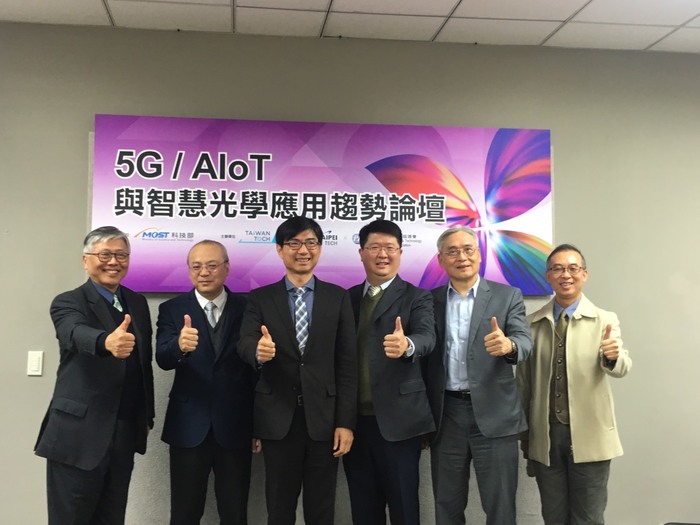Smart electro-optics to initiate AI TAIWAN in the 5G era

The Internet of Things has been applied to all kinds of devices for a more convenient life, and it is going to be combined with the artificial intelligence with the coming of the new 5G era in 2020.
Photonics Industry & Technology Development Association (PIDA) and Taipei Tech International Academic-Industry Alliance (IAIA) saw the potentials of such combination, and therefore hosted the Trends Forum on the Application of 5G/AIoT and smart electro-optics. This also meets the goals of the AI TAIWAN project implemented by the Ministry of Science and Technology (MOST) to initiate future technology with smart electro-optics.
The forum assembled the distinguished guests from both academia and the industries in the regarding fields to discuss the development of the coming 5G era.
Yung-Shun Chuang, Chair of AAEON Technology Inc., indicated that the 5th generation mobile network facilitates smart manufacturing which caters to a wider variety of the needs with its flexibility and high bandwidth memory.
Lung-Chien Chen, Chair of Taipei Tech Electro-Optical Engineering presented his opinion on the Mini/Micro LED’s techniques, application, and the positive influences it can bring about. Its thinness, low power consumption, high luminance, longer longevity can fulfill more requirements in the microdisplay devices.
Hai-Han Lu, Lifetime Distinguished Professor of Taipei Tech Electro-optical Engineering, focused on the cost of building up fiber-optic communication in combination with 5G/6G. He indicated the costs of building 6G could be much lower than 5G for its more advanced hardware and fiber-optic communication system.
Ying-Yi Lin, Director of PIDA, highlighted the electro-optical techniques applied to the advanced driving assistance system (ADAS) of intelligent vehicles. The upgraded image sensors, he said, are able to more effectively assist self-driving, and even to improve road traffic safety.
Chiu-Hui Chiu, Chair of the MOST Academia-Industry Collaboration, and Jia-Hua Lee, Director of Taipei Tech IAIA, both kept promoting the academia-industry collaboration which can energize the capacity of research and development of the corporations so as to keep up with the global supply chain.
The Internet of Things has been applied to all kinds of devices for a more convenient life, and it is going to be combined with the artificial intelligence with the coming of the new 5G era in 2020.
Photonics Industry & Technology Development Association (PIDA) and Taipei Tech International Academic-Industry Alliance (IAIA) saw the potentials of such combination, and therefore hosted the Trends Forum on the Application of 5G/AIoT and smart electro-optics. This also meets the goals of the AI TAIWAN project implemented by the Ministry of Science and Technology (MOST) to initiate future technology with smart electro-optics.
The forum assembled the distinguished guests from both academia and the industries in the regarding fields to discuss the development of the coming 5G era.
Yung-Shun Chuang, Chair of AAEON Technology Inc., indicated that the 5th generation mobile network facilitates smart manufacturing which caters to a wider variety of the needs with its flexibility and high bandwidth memory.
Lung-Chien Chen, Chair of Taipei Tech Electro-Optical Engineering presented his opinion on the Mini/Micro LED’s techniques, application, and the positive influences it can bring about. Its thinness, low power consumption, high luminance, longer longevity can fulfill more requirements in the microdisplay devices.
Hai-Han Lu, Lifetime Distinguished Professor of Taipei Tech Electro-optical Engineering, focused on the cost of building up fiber-optic communication in combination with 5G/6G. He indicated the costs of building 6G could be much lower than 5G for its more advanced hardware and fiber-optic communication system.
Ying-Yi Lin, Director of PIDA, highlighted the electro-optical techniques applied to the advanced driving assistance system (ADAS) of intelligent vehicles. The upgraded image sensors, he said, are able to more effectively assist self-driving, and even to improve road traffic safety.
Chiu-Hui Chiu, Chair of the MOST Academia-Industry Collaboration, and Jia-Hua Lee, Director of Taipei Tech IAIA, both kept promoting the academia-industry collaboration which can energize the capacity of research and development of the corporations so as to keep up with the global supply chain.
